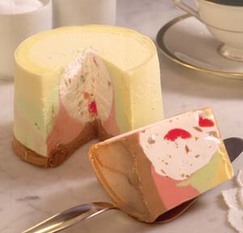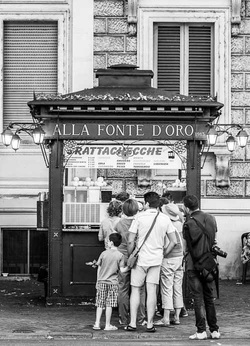 Congelato is the Italian word for frozen. Freddo means cold (sort of the way Don Michael Corleone felt toward his brother, Fredo). Freddo is the way Italians feel all the time, even in when it's warm out. It's a puzzle and a wonder that they have embraced something so cold and frozen as gelato. If you travel to Italy in summer--you--as an American, are going to want to do anything you can to keep cool. Not that Italians want this. They are always cold anyway. Italian air conditioning isn't really cold by American standards, either. Let's just say most Americans will get pretty heated on this subject. Even in the winter, temperatures can be mild to warm for American travelers, while Italians get out their scarves and puffy jackets in early September. But wait... I think I get it! Perhaps they are always wearing puffy jackets and scarves simply because they eat SO MUCH gelato each and every day, sometimes more than once a day. And, unlike in the States, where ice cream shops close down during winter, in Italy, the gelaterie are open all year long! Perhaos this lowers the core body temperature of Italians! Ah-HA! I think I've discovered something here. Maybe that's the difference--we can take the cold weather more, simply because we don't eat as much ice cream in the cold months as Italians do. Perhaps the reason gelateria suddenly offer cioccolato caldo in winter is so Italians can bring their core body temperature back up toward normal after having a winter gelato treat! (By the way... cioccolato caldo is amazing in Italy... made from real melted chocolate). So, what frozen treats await the traveler in Italy? I'll get into the types of frozen treats Italy has to offer, but first a little... History of Ice Cream  Italian Ice Cream Vendor in Wales. Italian Ice Cream Vendor in Wales. Believe it or not, Americans have been eating ice cream since the 1740s, and flavored icy treats were in many cultures dating back over a thousand years. Many of the Italian immigrants arriving at Ellis Island were already well aware of the pleasures of ice cream... or gelato, as they called it. Perhaps knowing this, officials at Ellis Island started serving immigrants ice cream because they thought it was "an efficient method for making our future citizens more at home in their new environment.” Of course, to Italians, the cold treat was nothing new. Iced desserts actually date back over a thousand years (even in ancient Rome) and they are common in many cultures. The history of gelato dates back to frozen desserts in Sicily, ancient Rome and Egypt (part of the Roman Empire in 30 BC) made from snow and ice brought down from the volcanoes Etna and Vesuvius, and covered with honey or fruit juices. Some stories claim that Nero, the Roman Emperor, invented a type of sorbet in the first century AD by having runners along the Appian Way pass buckets of snow--relay race style--from the mountains to his palace, where it was flavored with honey and wine. During the Italian Renaissance, the great history of modern Italian gelato really began to take off. The Florentine Medici family held a contest for the best frozen dessert. A peasant named Ruggeri, a chicken farmer and amateur chef, took part in the competition, creating a dessert of fruit juice and ice--similar to sorbet. Ruggieri won the competition which immediately brought him fortune and fame after Caterina de Medici took him with her to France. Caterina was using him to shame the over-inflated egos of the French chefs serving the French court and prove that Florentines made the best desserts. In fact, Ruggieri, made his creation for Caterina on her wedding day when she married the future King Henry II of France. Later in the 1500s, the Medici commissioned artist and architect Bernardo Buontalenti to create a culinary event for the King of Spain. Buontalenti came up with a creamy frozen dessert that we now call gelato. Because of this, many consider Buontalenti as the inventor of the gelato we enjoy today. (Another great Italian innovator!) In 1686 the Sicilian fisherman Francesco Procopio dei Coltelli perfected the world's first first ice cream making machine--and no, it didn't plug in. (Italians invented a lot!) Coltelli's fame made him a rich man and he soon opened an incredibly successful cafe in Paris where his creamy gelato gained a wide-spread reputation. However, it wasn't until the 1920s and 1930s, when the first gelato cart was developed in the northern Italian city of Varese (take that, Good Humor), that gelato started to become popular with more and more people in Italy itself. In 1770, just before the American Revolution, Giovanni Basiolo brought gelato to New York. He brought two kinds of of gelato-- one made by blending milk with coffee, chocolate, or pistachio, and another made with water and fruits. In 1846, the hand cranked ice cream machine was perfected and made the velvety and creamy dessert simple, yet fatiguing to produce. Types of Frozen Delights  During the 1900s, the advance of technology helped ice cream become even more widespread--and in all seasons of the year. The introduction of ice houses, faster shipping, and horse-drawn ice cutters led to a drop in the price of ice. This led to a huge market for ice production and distribution. In America, the ice storage houses shut down and people no longer harvested ice from frozen ponds in the winter months. Many people could finally afford iced treats during the hot summer months and by the 1840s, ice cream was being sold on the streets of both Europe and America. Italians immigrants are credited with creation of ice cream and they became strongly associated with the production and selling of ice cream in both Europe and America. In England, where Italians emigrated in large numbers after 1860, the selling of ice cream was seen as a predominantly Italian occupation, with immigrants from Rome and Naples owning most of the ice cream carts. In fact, the Italians were responsible in exporting ice cream vendors in many European counties and to America. So, Italians not only brought us pizza and pasta, but ice cream as well!  Semifreddo Semifreddo translates as semi-cold. You will find this light and mousse-like ice cream in the gelateria also. Even though it's lighter and softer it's actually colder. Although fine in a cup, if you order semifreddo in a cone it will melt a lot faster than gelato. You'll know it's semifreddo because it is usually mounded very high in the tub... much more so than gelato.  Gelato This is what everyone thinks of when they think of Italian ice cream. Gelato (plural, gelati) is the Italian word for ice cream, coming from the Latin word for frozen, gelatus. Gelato can be made with milk, cream, various sugars, and flavoring such as fresh fruit and nut purees. It is often made with skim milk and is generally lower in calories, fat and sugar than American style ice cream. Typically, gelato—like any other ice cream—needs a stabilizing base. Egg yolks are used in yellow custard-based gelato flavors, including zabaione (also, zabaglione) and crema al caramello (creme caramel). Over 55% of the gelato made in Italy is hand-mixed. There is an enormous variety of flavors. You will often find a gelato shop open during lunchtime, when other shops and even restaurants are closed. So, if you're hungry and need fuel, your choices are going to a bar (more like a breakfast/lunch bar) where many also have gelato, or go to a gelateria! The same goes for the end of the day. Most restaurants don't open until 7:30 - 8:00 pm at night, so feel free to let the kids have a gelato to hold them over at around 5 o'clock. The servings are usually smaller than Americans are used to and your kids won't get too filled up before dinner. You can order gelato in a small cone or in a cup... but there's a bit more to know. First, you tell the cassiere (cashier) what you want (how many cones or cups, how many flavors) then you pay for it. The cassiere will give you a receipt. Then you take your receipt over to the person scooping the gelato (they are usually, but not always, two different people). Now you can ask for either a cup (coppa, coppe for plural) or cone (cono, coni for plural). You can also tell them "piccolo" for small "grande" for large. For mixing flavors try, "mezzo _____ e mezzo ____" for "half chocolate and half vanilla" or whatever flavors you want to try. It's normal to ask for two flavors in a single cup. So, it might go like this... "Una piccolo cuppa... mezzo cioccolato, mezzo coco.... e due coni con crema". (One small cup, half chocolate, half coconut... and two cones with custard cream). I'll go over some flavor names: Chocolates
Miscellaneous
 Granita Granita (or granita Siciliana) is a semi-frozen dessert made from sugar, water and various flavorings. Originally from Sicily, it is available all over Italy in somewhat different forms. It is related to sorbet and Italian ice; however, in most of Sicily, it has a coarser, more crystalline texture. The texture can vary from town to town, even across the island of Sicily. This is largely the result of different freezing techniques: the smoother types are produced in a gelato machine, while the coarser varieties are frozen with only occasional agitation, then scraped or shaved to produce separated crystals. Although its texture varies from coarse to smooth, it is always different from the one of an ice cream which is creamier, and from the one of a sorbet, which is more compact; this makes granita distinct and unique.  Shakerato It makes sense that the Italians would invent a most exquisite coffee drink for the summer. It's a shaken-over-ice, slightly sweetened espresso called shakerato, served in a stemmed glass, prepared in bars all over the county. The shaking process yields a thick crema that floats on the espresso. In Italy, ice is viewed with suspicion, and you'd never be served a tall glass of coffee over lots of ice, the way iced coffee is in the U.S. Italians think that would cause a serious stomach ache. Make your own:
Shake the hot espresso, ice, and sugar syrup energetically until ice is almost completely melted--you'll know by the sound of the cubes. Strain into a stemmed glass. Don't try to make more than two or three at a time.  Biscuit Tortoni Biscuit Tortoni is an ice cream made with eggs and egg whites, along with heavy cream, often containing chopped cherries or topped with minced almonds or crumbled macaroons. It is believed to be named after an Italian café owner in Paris in the 18th century. I remember this cold treat from my childhood--every really good Italian restaurant offered either spumoni or tortoni for dessert, and tortoni was my personal favorite. The almond flavor in tortoni is the star.  Sorbetto Sorbetto (sorbet in English) is a frozen dessert made from a simple syrup for sweetening, water and flavored with fruit juice, fruit purée, fruit nectar, wine, or liqueur. Unlike gelato or ice cream, it never contains milk or cream. Although considered a low fat alternative to gelato, the additional sweetness can itself add calories. Some think that sorbetto is exactly like sherbet as Americans know it. It isn't... sherbet contains dairy products.  Spumone Spumoni is an Italian dessert made of layers of gelato, whipped cream, candied fruit, and nuts. In America it's spelled spumoni. It contains different layers of flavors and ingredients. In traditional style, it is made in three layers: chocolate, pistachio, and cherry. The chocolate layer would contain bits of chocolate shavings or crushed hazelnuts. The pistachio layer always includes crushed pistachios. The cherry layer has candied cherries in it. It is also made with other fruit layers.  Grattachecca Grattachecca literally translates as scratchy. It is a frozen street treat popular in Rome. It's not ice cream.... it's ice--shaved ice. The vendor stands in front of a large block of ice and scrapes the block with a metal shaving tool. Once the shaved ice is in the plastic cup, a flavored syrup and fruit are added. Flavor choices are usually black cherry, tamarind, mint, barley water, coconut or lemon. In the early 1900s, large blocks of ice called checca were used to cool food and drink. An innovative vendor came up with the idea to grate, or grattare, the ice and make a drink. This is where the name grattachecca came from.  Tartufo Tartufo translates as "truffle" and is hand sculpted to look like a very large one. It is made with two flavors of ice cream and typically has either fruit syrup or frozen fruit—typically raspberry, strawberry or cherry--in the middle. This frozen dessert originates from Pizzo, Calabria. Chocolate is melted poured over the ice cream ball after being cooled. The outer coating may also be cinnamon or cocoa--giving a more realistic truffle look--with the bomba shape rolled in cinnamon or cocoa before freezing. There are usually chopped or crushed nuts on top.  Affogato If you're an espresso lover, try an affogato (Italian, drowned). Basically, it's a scoop of vanilla gelato drowned with a shot of hot espresso. Some variations also include a shot of amaretto or other liqueur.  Zuccotto Zuccotto is an Italian dessert with origins in Florence. Zuccotto is a semi-frozen, chilled dessert made with semifreddo, brandy, and spongecake and often flavored with espresso--essentially, it's an ice cream bombe. The word Zuccotto is a joining of two words.... zucca (pumpkin) and cotto (cooked). Some think it's a corruption of zucetto (skullcap), which happens to the the shape of this cold treat. It can be frozen, then thawed before serving. This dessert is traditionally made in a special pumpkin-shaped mold. In the end, there are always alimentari, bar-tabacchi and gelato trucks that will have basic flavors of gelati and an offering of Cornetto cones and other ice cream pops in their freezer display case. There are more than enough ways to cool down when you visit la Bella Italia. But just remember, if you get brain freeze and get too chilly, there's always a puffy jacket with your name on it.... That's when you really know that you've become a local. --Jerry Finzi If you enjoyed this article, please SHARE it and LIKE it on your favorite social media site. Ciao! We also have pages on: Google+ Copyright, 2015-2019, Jerry Finzi/GrandVoyageItaly.com - All rights reserved
1 Comment
|
Categories
All
Archive
June 2024
|










 RSS Feed
RSS Feed
